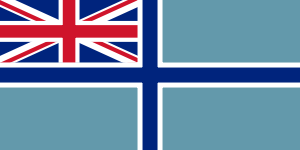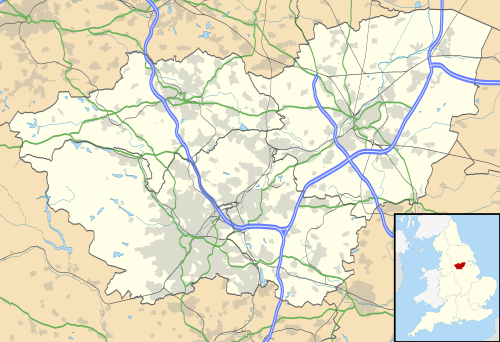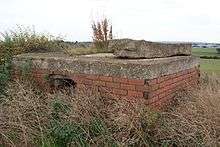Netherthorpe Airfield
| Netherthorpe Aerodrome RAF Netherthorpe   | |||||||||||||||
|---|---|---|---|---|---|---|---|---|---|---|---|---|---|---|---|
 | |||||||||||||||
| IATA: none – ICAO: EGNF | |||||||||||||||
| Summary | |||||||||||||||
| Airport type | Private | ||||||||||||||
| Location | Worksop | ||||||||||||||
| Elevation AMSL | 254 ft / 77 m | ||||||||||||||
| Coordinates | 53°19′01″N 001°11′47″W / 53.31694°N 1.19639°WCoordinates: 53°19′01″N 001°11′47″W / 53.31694°N 1.19639°W | ||||||||||||||
| Website | Flying at Netherthorpe | ||||||||||||||
| Map | |||||||||||||||
 EGNF Location in South Yorkshire | |||||||||||||||
| Runways | |||||||||||||||
| |||||||||||||||
Netherthorpe Airfield (ICAO: EGNF) is located 2 NM (3.7 km; 2.3 mi) west by north of Worksop, Nottinghamshire, England. The airfield is in the Metropolitan Borough of Rotherham.
Netherthorpe is operated by Sheffield Aero Club, it is part of a local landowners estate. There are two flying training schools present, the Sheffield Aero Club and Phoenix Flying School. Sheffield Aero Club have three hangars, (Numbers 1 to 3) these house the operational aircraft types, training aircraft are parked outside. Aircraft maintenance is available from Dukeries Aviation Ltd, Phoenix Flying School's parent company, they operate from the single maintenance hangar.
Netherthorpe Aerodrome has a CAA Ordinary Licence (Number P601) that allows flights for the public transport of passengers or for flying instruction as authorised by the licensee (Sheffield Aero Club Limited). The aerodrome is not licensed for night use (though it was until the 1990s).[2]
History
The First 'Privateers' and Sheffield Aero Club
The land on which the current airfield is located was originally used for flying in 1933 by a small number of private pilots with their own aircraft, they operated the de Havilland DH.60 Moth. They approached Sheffield City Council on Friday 5 April 1935 with the intention of taking advantage of the growing trend in airfield development and forming the Sheffield Aero Club (SAC). Following protracted negotiations funding was found for a clubhouse which was originally located to the right of the existing runway 24 threshold and to upgrade an existing hangar, located to the left of the existing runway 24 threshold, this was extant until 1996 when it was destroyed by high winds. The landing ground also received upgrade. The convention at the time was to take off and land using the whole mown field with no designated runways, a white circle was whitewashed to identify the centre of the field where take off and landing was conducted through the circle, the identification letters 'NT' were enclosed in the circle. After initial hesitation mitigated by hedge removal to reveal a larger landing area the Air Ministry (AM) approval was granted to allow flying training, operating the De Havilland Moth which was loaned to the club by the Chairman Mr Jakeman with operations starting on 31 July 1935. BA Swallow G-AEIC moved to Netherthorpe in 1939 owned by club director Mr Horrox though it is unclear if this was used by the wider club membership but would be commandeered by the Royal Air Force (RAF) as a communication aircraft on their arrival at Netherthorpe in 1940. On the declaration of war with Germany on 3 September 1939 a AM telegram was signalled to all flying clubs to cease operations immediately, the airfield was closed and studded with wooden spikes to deter landing German aircraft and paratroopers. [3]
Second World War


Following a signal from No. 22 Group RAF the first RAF personnel arrived at Netherthorpe on 28 June 1940, the airfield anti-landing spikes being removed covertly during the night, the advanced air movement of a flight of Westland Lysander Mk II aircraft of No. 613 Squadron RAF of the Royal Auxiliary Air Force arriving from RAF Odiham shortly afterwards. Once up to strength utilising their Lysanders along with their Miles Magister (L8056) and de Havilland Tiger Moth (N9279) communications aircraft together with the aforementioned civilian BA Swallow, 613 were detailed to patrol the east coast up to 5 miles inland and up to 5 miles out to sea in two areas. Area 'A' patrolled from Humber to the Wash and Area 'B' from Humber to Filey. They were to report on any invasion activity which included photographic reconnaissance, the Lysanders would have been fitted with bombs and used their wheel mounted and rear gunner operated twin .303 machine guns to attack the eastern beaches during a German invasion. Post war analysis shows the invasion beaches were to be on the English south coast and the 613 patrolled areas did not feature on the initial invasion plans of Operation Sea Lion though this might have changed as the land battle for Britain unfolded. Though heavily engaged with army co-operation 613 also flew 'Jim Crow' sorties searching for downed RAF aircrew, leading RAF High Speed Launches to the stricken flyers. The Lysanders were dispersed in nearby Scratta woods with field hedges removed to provide access to the airfield (behind the modern airfield building). The airfield defences were upgraded with six type 22 pill boxes (see British hardened field defences of World War II) built around the airfield perimeter along with slit trenches and three anti-aircraft gun emplacements utilising the Vickers machine gun, two pill boxes were extant in 2016. The army manned these defences and were billeted in the loft of Bottom Farm's barn, which was situated close to the perimeter of the airfield. The officers mess was located at nearby Thorpe Hall in Thorpe Salvin village with other ranks under canvas including lower ranked officers, sanitation and water were rudamentry with 'going to ground' latrines. A fatal accident occurred on 6 September 1940 when lysander P1692[4] flown by Pilot Officer Grosvenor Louis Edmunds (1917-1940) collided on landing with a RAF Lorry, the Lysander's wheels snagging the hoop supports for the canvas covering of the lorry, Pilot Officer Edmunds died of his injuries in hospital on 13 September 1940, his air gunner Sgt. Letham was rescued and survived. A plague and portrait at SAC commemorates this. Ignoring the exploding ammunition and fire LAC Richard John Farley and AC1 Thomas William Coop were the RAF ground crew who rescued Edmonds and Letham from the aircraft. They were later awarded the George Medal for their actions.[5]
On 7 September 1940, 613 moved to nearby RAF Firbeck, Netherthorpe was left with obstacles to deter enemy aircraft from landing but with a known emergency landing area for a Lysander if required. In May 1941 while stationed at Firbeck, 613 started practicing high and low level dive bombing strategy, a large target outline of a battleship being painted on the ground at Netherthorpe. After 1941, although the RAF retained operation of the airfield, there was virtually no activity. [6]
Post-war use
In 1945 No.24 Glider School RAF operated from the airfield, utilising the Cadet TX.1, TX.2 and TX.3 (see Slingsby Kirby Cadet) and the Sedbergh TX.1 (see Slingsby T.21). In 1951 the RAF relinquished control of the airfield and it was handed back to the landowner, the glider unit moving to RAF Lindholme. Little use of the airfield was made until 1961 when the SAC reformed.[7]
Current use


In 1961 the SAC reformed at Netherthorpe and in 2016 featured a clubhouse; with a garden leading out onto the airfield, four hangars; one hangar used for aircraft maintenance and another incorporating the fire tender shed, an operations block and control tower are also present along with a 100LL fuel bowser. During the late 1990s Phoenix Flying School was established by Dukeries Aviation Ltd operating out of the maintenance hangar.
References
- ↑ Netherthorpe - EGNF
- ↑ Civil Aviation Authority Aerodrome Ordinary Licences
- ↑ North, Roger, Netherthorpe at war: a history of the airfield to the end of the Second World War (1996) ISBN 0952721201
- ↑ 613 sqn operational diary
- ↑ Further details at Rotherham War Memorials
- ↑ North, Roger, Netherthorpe at war: a history of the airfield to the end of the Second World War (1996) ISBN 0952721201
- ↑ North, Roger, Netherthorpe at war: a history of the airfield to the end of the Second World War (1996) ISBN 0952721201